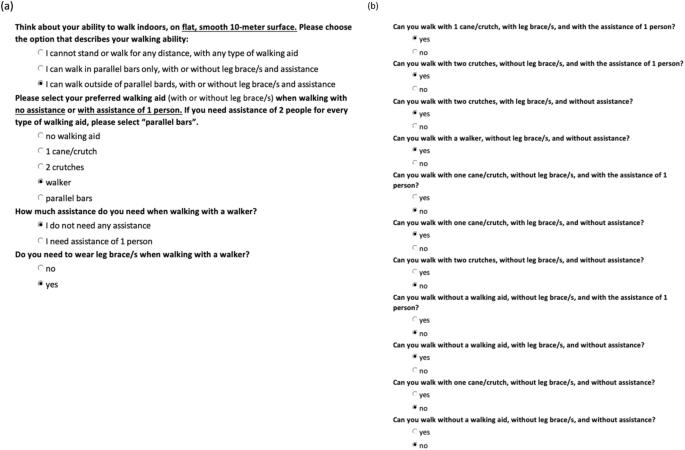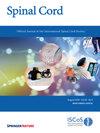脊髓损伤行走指数 II (WISCI)的治疗师管理自我报告版本:心理计量学研究
IF 2.2
4区 医学
Q3 CLINICAL NEUROLOGY
引用次数: 0
摘要
研究设计心理测量学研究研究地点澳大利亚和意大利的脊髓损伤(SCI)康复中心参与者从方便抽样中招募了八十名脊髓损伤患者。两个版本均通过在线平台在澳大利亚进行英语测试,在意大利进行意大利语测试。第一个自我报告版本(SR-V1)的格式与最初的面对面 WISCI II 相似。第二个自我报告版本(SR-V2)有更多的问题,但每个问题都要求参与者一次只关注行走的一个方面。受试者在研究物理治疗师的协助下分两次完成 SR-V1 和 SR-V2,每次间隔三到七天。然后,由一名独立的物理治疗师通过面对面评估的方式对最初的 WISCI II 进行施测。通过类内相关系数(ICC)和接近百分比确定了 SR-V1 和 SR-V2 的评分者内部信度和效度。两个自我报告版本的有效性和可靠性非常相似,SR-V2 略优于 SR-V1。SR-V2 的 ICC(95% 置信区间)为 0.87(0.81-0.92)。反映自我报告与面对面 WISCI 之间一致性的 ICC 为 0.89 (0.84-0.93)。本文章由计算机程序翻译,如有差异,请以英文原文为准。

A therapist-administered self-report version of the Walking Index for Spinal Cord Injury II (WISCI): a psychometric study
To develop a self-report version of the Walking Index for Spinal Cord Injury II (WISCI II) and to test its reliability and validity. Psychometric study. Spinal cord injury (SCI) rehabilitation centres in Australia and Italy. Eighty people with SCI were recruited from a sample of convenience. Two self-report versions of the WISCI II were developed. Both versions were administered in English at the Australian site, and in Italian at the Italian site through an online platform. The format of the first self-report version (SR-V1) was similar to the original face-to-face WISCI II. The second self-report version (SR-V2) had more questions, but each question required participants to focus on one aspect of walking at a time. Participants completed SR-V1 and SR-V2 with assistance from research physiotherapists on two separate occasions, three to seven days apart. The original WISCI II was then administered through a face-to-face assessment by an independent physiotherapist. The intra-rater reliability and validity of SR-V1 and SR-V2 were determined with intraclass correlation coefficients (ICC) and percent close agreements. The data from the Australian and Italian sites were pooled. The validity and reliability of the two self-report versions were very similar, with SR-V2 performing slightly better than SR-V1. The ICC (95% confidence interval) of SR-V2 was 0.87 (0.81–0.92). The ICC reflecting the agreement between the self-report and the face-to-face WISCI was 0.89 (0.84–0.93). Both versions of the self-report WISCI II provide a reasonable substitute for a face-to-face assessment although therapists preferred SR-V2.
求助全文
通过发布文献求助,成功后即可免费获取论文全文。
去求助
来源期刊

Spinal cord
医学-临床神经学
CiteScore
4.50
自引率
9.10%
发文量
142
审稿时长
2 months
期刊介绍:
Spinal Cord is a specialised, international journal that has been publishing spinal cord related manuscripts since 1963. It appears monthly, online and in print, and accepts contributions on spinal cord anatomy, physiology, management of injury and disease, and the quality of life and life circumstances of people with a spinal cord injury. Spinal Cord is multi-disciplinary and publishes contributions across the entire spectrum of research ranging from basic science to applied clinical research. It focuses on high quality original research, systematic reviews and narrative reviews.
Spinal Cord''s sister journal Spinal Cord Series and Cases: Clinical Management in Spinal Cord Disorders publishes high quality case reports, small case series, pilot and retrospective studies perspectives, Pulse survey articles, Point-couterpoint articles, correspondences and book reviews. It specialises in material that addresses all aspects of life for persons with spinal cord injuries or disorders. For more information, please see the aims and scope of Spinal Cord Series and Cases.
 求助内容:
求助内容: 应助结果提醒方式:
应助结果提醒方式:


